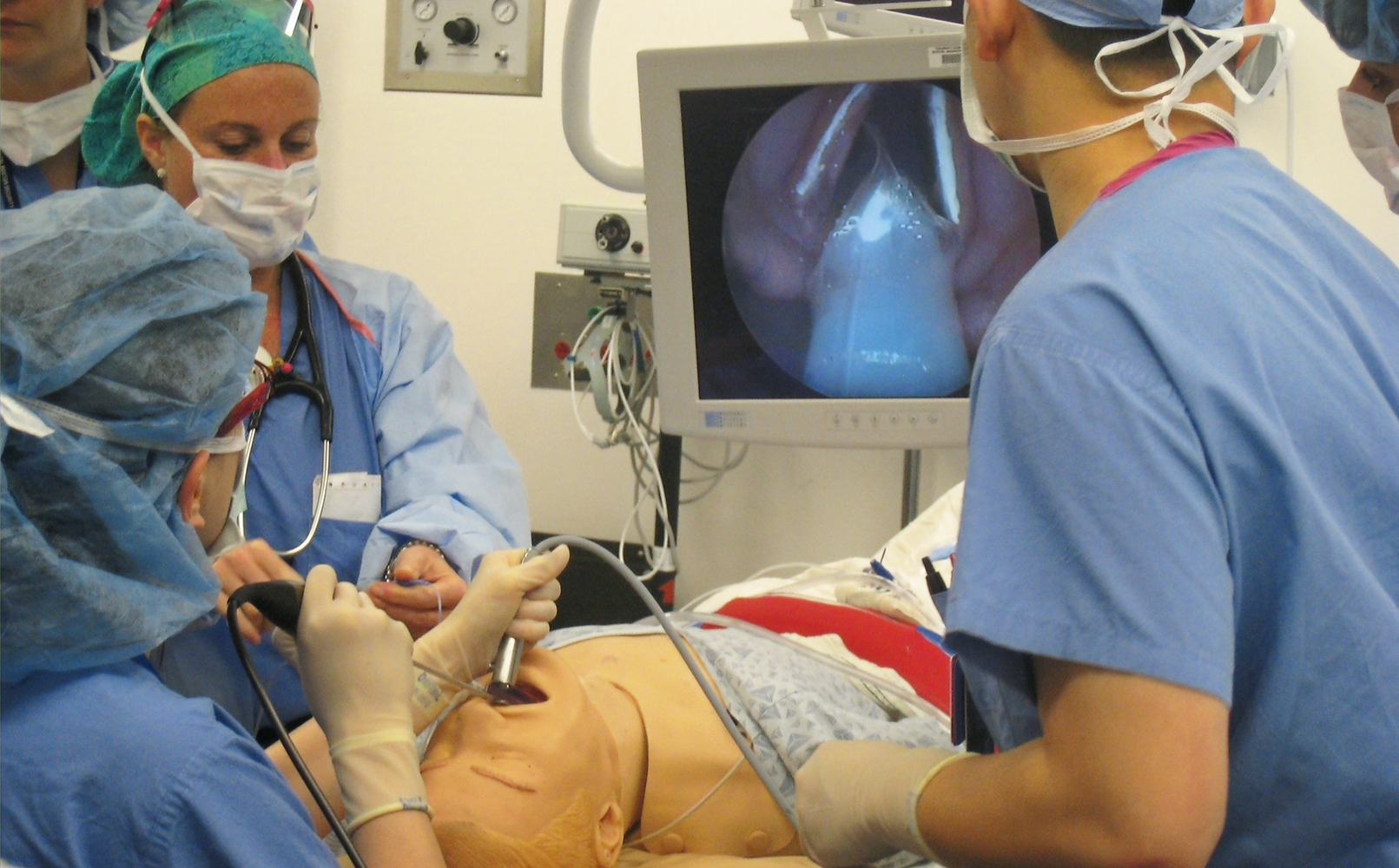
Welcome to ORLpedsim.com
The Medical Simulation site for the Department of Otolaryngology and Communication Enhancement at Boston Children's Hospital.

What is Simulation?

Simulation is an experiential technique (not a technology) that is used by individuals, teams, and organizations to learn and practice how to do things better. A golfer taking a practice swing or an airline pilot using a flight simulator to learn a new aircraft procedure are two examples of simulations.
In medicine, simulation is used to teach skills and procedures, improve teamwork and communication, identify latent safety errors, design facilities and help implement strategies.
Medical Simulation and Otolaryngology Education

Becoming a competent otolaryngologist requires assimilating the requisite knowledge, skills, and attitudes. Knowledge is acquiring information, the book-learning aspect of education. Skills are learning to perform a task, the procedural piece of the puzzle. Finally, attitude is the motivation and values associated with integrating into the culture of medicine, setting goals, communicating with patients, and acting in a moral, ethical manner.
Much of knowledge attainment can be done on one’s own. But the integration of that knowledge, along with the acquisition of skills and attitude development, is learned through experiences. These may range from starting an IV, working up a new patient on the wards, observing and then doing an operation, or witnessing good examples set by mentors.
However, because of the high stakes involved in medical care, not all experiences are readily accessible to trainees. This leads to the following medical education enigma:
Good judgment comes from experience
…and experience comes from bad judgment. - anonymous
Heading a surgical team in managing a critical airway, supervising junior providers during an intraoperative complication, or communicating effectively during a crisis are all capabilities that otolaryngologists need to acquire. How then do trainees overcome the above stated paradox and gain experience (and good judgment) in high-risk situations to the patient? Simulation can unravel the conundrum. By making typically high-risk events completely safe, simulation can impart to ORL trainees learning experiences that are ordinarily unavailable.
Why this website?

The purpose of this website is to give an overview of the simulation activities in the Department of Otolaryngology and Communication Enhancement. Since 2006, the department, in partnership with IDS (Immersive Design Systems) at Boston Children's Hospital, has been using simulation to enhance its education programs. Simulation activities happen regularly and include:
1) CICU/ORL (Cardiac ICU/Otolaryngology) Course – For pediatric ORL fellows and intermediate fellows. CICU nurses, a respiratory therapist, and either CICU fellows or CICU attendings round out the participating group. This course is similar to the NOA Course except that in addition to developing good non-technical skills, its goals include exchanging primary airway and cardiovascular content between the two teams.
– Given three times per year.
2) CORES (Children’s Otolaryngology Residents’ Emergency Skills) Course – Basic skills training for junior ORL providers. It offers first-year ORL residents and new APPs hands-on experience in essential skills such as suturing, assembling rigid bronchoscopy equipment, managing epistaxis, and using an operating microscope, all under close faculty supervision.
- Given once per year to junior ORL personnel throughout New England.
3) CRICO Simulations - Multidisciplinary simulation courses for ORL attendings focusing on a variety of technical and non-technical skills. These are mandatory for all ORL attendings and follow a three-year recurrent cycle. Year 1 includes a four-hour in-situ OR simulation, Year 2 features a one-hour Simulation Safety Drill, and Year 3 offers a 2-4 hour “Chairman’s Choice.” Each scenario is thoroughly debriefed.
- Conducted in four sessions annually.
4) NOA (Nursing, Otolaryngology, and Anesthesia) Course - Designed for intermediate ORL residents and pediatric ORL Fellows, these multidisciplinary simulations take place in the Main ORs at Boston Children’s Hospital (BCH). Staff OR nurses and anesthesia trainees form part of each team. The sessions include a didactic segment, two scenario-based exercises, and two debriefs. The scenarios challenge the OR team to handle straightforward intraoperative ORL crises in a moderately time-pressured setting. The course aims to introduce participants to key non-technical skills such as teamwork, communication, and Crisis Resource Management (CRM) principles.
– Given four to six times per year.
5) 3D Printing - The BCH ORL department uses the extensive 3D printing capabilities of IDS (Innovation Design Systems - formerly the BCH Simulator Program). 3D prints are often used to preplan surgeries such as extensive base of skull tumor resections or complex temporal bone cases. Additionally, the department has set up a pediatric temporal bone lab within one of the IDS simulation spaces. This allows pediatric ORL fellows to practice the facial recess approach and electrode placement in simulated infant temporal bones before doing the same surgery on an actual patient. Synthetic temporal bones are purchased from Phacon and are available for various ages. This lab is also available for surgical preparation of complex base of skull procedures by enabling the drilling of presurgical 3D prints.
- Given intermittently during the year.
6) QA/QI Improvements - The department’s in situ simulations are often a basis for discovering latent safety errors. Errors in either protocols or equipment found during simulation are reported to the administration and discussed during ORL departmental M&M conferences to prevent similar episodes during actual patient care.
